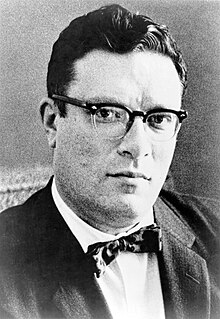Convention of Space Explorers
Covenant of space explorers (also The waning night ; Original title: The Dying Night ) is an approximately 28-page science fiction - short story by Isaac Asimov in 1956, in the murder of Romano Villiers and the theft of his method of mass transfer through the detective Wendell Urth is cleared up.
content
The astronomers Dr. Edward Talliaferro of the Moon , Dr. Battersley Ryger of Ceres and Dr. Stanley Kaunas from Mercury are college friends and meet again after ten years on earth for an interplanetary, astronomical convention. In this long time they have got used to the conditions of their alien workplaces and the earth conditions cause them difficulties.
Through a letter they learned that another college friend, Dr. Romano Villiers, who is attending the convention and would like to meet her beforehand. The eccentric, aggressive Villiers could never leave the earth because a rheumatic fever had weakened his heart. He blames his college friends for this. When they meet Villiers in his hotel room, they see how much his illness troubles him, but he immediately tackles it in his aggressive manner and triumphantly mentions his publication on a method of mass transfer that he will present during the convention. There is only one paper copy of this method and he teleported a mouse in front of witnesses. If it worked with people, he, Villiers, could easily travel the solar system and would have outdone his college friends, because none of them had achieved breakthrough successes in the ten years. After this announcement, he refers them to his room and they are convinced that he has gone insane. Nevertheless, all three go back to Villiers together later that evening to clear up the situation.
The next morning they are visited by Hubert Mandel, who witnessed Villier's mouse teleportation, and found out that Villiers had succumbed to his heart condition from excitement last night. His publication was also stolen and snippets of it were found in the incinerator. When Mandel learns that all three men had visited Villiers the previous evening, he suspects that one of them may have stolen, scanned and destroyed Villier's publication . He calls in their small, portable scanners to develop the films they contain. Apparently the film was exchanged and hidden in a scanner, because none of the films shows the missing publication. All day long, assumptions and accusations go back and forth and Mandel himself is accused of the act. When they examine Villier's room together, they find a scanner film on the outside window sill. The sun has not yet completely destroyed it and after the development it turns out that it actually contained parts of Villier's publication.
At this point, Mandel decides to bring in an old friend, the eccentric detective Wendell Urth. Urth is known for the fact that he never travels out of dislike and solves all cases by thinking through it. Urth listens to all the descriptions and comments, asks a few additional questions and is then sure to have solved the case: The culprit hid the film on the window ledge on the night of Villiers because this person, due to his long absence from the Earth didn't expect the morning sun to come up and destroy the film. But only Dr. Stanley Kaunas, whose observatory is on Mercury's night side because of the heat. Faced with the facts, Stanley Kaunas admits that he visited Villiers that night and stole and scanned Villiers' publication. In return for his detective work, Urth demands that he would like to be informed if mass transfer should become a travel option. He would then like to visit a childhood sweetheart in Lower Falls, New Hampshire.
comment
This short story is one of Asimov's stories in which the detective Wendell Urth plays a role.
At the time the story was written, it was believed that Mercury had a bound rotation ; H. always turn the same side of the sun (on which Urth's conclusion and the solution to the case are based). Only in 1965 was it recognized through measurements that Mercury also rotates and so the entire surface is repeatedly exposed to the sun. Asimov commented on it that it was not his fault if astronomers at the time made a mistake.
Web links
reference
- English: The Dying Night , in The Best of Isaac Asimov , 1954–1972, Sphere Science Fiction, London (1977), Ed. Angus Wells
- German: Konvent der Weltraumforscher in Im Dschungel der Urzeit (Heyne Science Fiction & Fantasy), publisher Walter Ernsting, Heyne Verlag (1966)
Explanations
- ↑ “It is the earth. It doesn't feel right. I can't get used to it. ”Originally:“ It's Earth. It doesn't feel right. I can't get used to it. "
- ↑ "You set out into space and left me behind." Originally: "You went out into space and left me behind."
- ↑ Asimov describes how small scanners worn on a chain around their necks have become a clear attribute of scientists who can use them to collect information anytime and anywhere.
